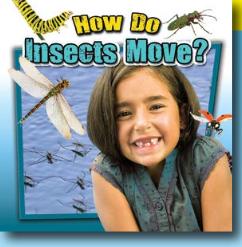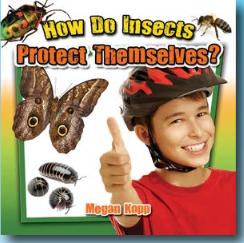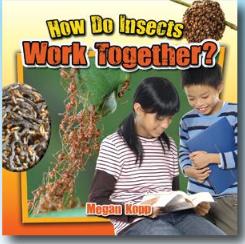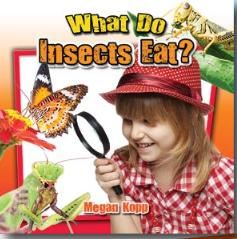| ________________
CM . . .
. Volume XXII Number 11. . . .November 13, 2015

 |
How Do Insects Move? (Insects Close-Up).
Megan Kopp.
St. Catharines, ON: Crabtree, 2015.
24 pp., pbk., hc., pdf & html, $8.95 (pbk.), $18.36 (RLB).
ISBN 978-0-7787-1974-8 (pbk.), ISBN 978-0-7787-1970-0 (RLB), ISBN 978-1-4271-9036-9 (pdf), ISBN 978-1-4271-9032-1 (html).
Subject Heading:
Insects-Physiology-Juvenile literature.
Kindergarten-grade 2 / Ages 5-7.
Review by Gail Hamilton.
*** /4
|
| |
|
 |
How Do Insects Protect Themselves? (Insects Close-Up).
Megan Kopp.
St. Catharines, ON: Crabtree, 2015.
24 pp., pbk., hc., pdf & html, $8.95 (pbk.), $18.36 (RLB).
ISBN 978-0-7787-1975-5 (pbk.), ISBN 978-0-7787-1971-7 (RLB), ISBN 978-1-4271-9037-6 (pdf), ISBN 978-1-4271-9033-8 (html).
Subject Heading:
Insects-Behavior-Juvenile literature.
Kindergarten-grade 2 / Ages 5-7.
Review by Gail Hamilton.
*** /4
|
| |
|
 |
How Do Insects Work Together? (Insects Close-Up).
Megan Kopp.
St. Catharines, ON: Crabtree, 2015.
24 pp., pbk., hc., pdf & html, $8.95 (pbk.), $18.36 (RLB).
ISBN 978-0-7787-1876-2 (pbk.), ISBN 978-0-7787-1972-4 (RLB), ISBN 978-1-4271-9038-3 (pdf), ISBN 978-1-4271-9034-5 (html).
Subject Heading:
Insects-Behavior-Juvenile literature.
Kindergarten-grade 2 / Ages 5-7.
Review by Gail Hamilton.
*** /4
|
| |
|
 |
What Do Insects Eat? (Insects Close-Up).
Megan Kopp.
St. Catharines, ON: Crabtree, 2015.
24 pp., pbk., hc., pdf & html, $8.95 (pbk.), $18.36 (RLB).
ISBN 978-0-7787-1977-9 (pbk.), ISBN 978-0-7787-1973-1 (RLB), ISBN 978-1-4271-9039-0 (pdf), ISBN 978-1-4271-9035-2 (html).
Subject Heading:
Insects-Food-Juvenile literature.
Kindergarten-grade 2 / Ages 5-7.
Review by Gail Hamilton.
*** /4
|
| |
|

excerpt:
You can skate on water when it is frozen. Water striders skate on water during the middle of summer. Striders are skinny insects with long legs. They have fine hairs on their feet. These hairs stop the strider’s legs from breaking through the water’s surface. This allows them to skate across the top of a calm pond or lake.
There are very few insect species that can walk on water. This means there is little need to fight for food. Water striders feed on spiders and insects that land on the water surface (From How Do Insects Move?)
Part of the “Insects Close-Up” series, these four titles introduce young readers to the diverse insect world. All of them begin in a similar fashion, explaining what an insect is and showing, by means of a photograph, the various parts of an insect’s body. The text, printed in a large, simple font, consists of a few short sentences per page and is easy for youngsters to comprehend. Throughout the text, there are "What do you think?" sections, each of which poses a question for readers. Some of the questions are very basic while others require a bit more consideration of the featured concept. Related activities found at the back of each book invite readers to draw a diagram, make a poster or fill in a chart to demonstrate what they have learned. The books' strength is mainly in the highly appealing colour close-up photographs. A table of contents, a "Words to Know" section, a brief index and a list of books and websites for further research are provided.
How Do Insects Move? explains that insects move in order to locate food or shelter, find a mate, communicate or to escape from danger. Different species can have different types of legs or wings, depending on their habitats. A grasshopper, for example, has strong back leg muscles which enable it to jump 20 times the length of its body while a mole cricket has large, powerful front legs that it uses to dig in the dirt to create burrows.
In How Do Insects Protect Themselves?, readers will find out how insects avoid predators: some use sight, sound, smell and even touch to sense approaching danger; some insects’ bright colouration warns predators to stay away; some are easily camouflaged or resemble other animals; and some release a smelly substance which predators dislike. Stinging insects, such as bees and wasps, use their nasty “bite” to defend themselves.
How Do Insects Work Together? focusses on insects that live in social groups- ants, termites, bees and wasps. In this title, there is information about the various roles in the group and the kinds of homes that the insects create. Readers might be surprised to find out that a single colony of driver ants in Africa can have as many as 20 million workers and that some species of termites sound an alarm to the entire nest by bashing their heads against a surface.
Finally, What Do Insects Eat? features the various types of mouth parts that are designed to eat a specific kind of food. Powerful jaws made up of two mandibles that move from side to side enable chewing insects to hold, bite and chew their food, while hollow tubes, much like drinking straws, help nectar-sippers, such as bees and butterflies, to sip liquid nectar. Mosquitoes have hollow tubes as well, but theirs have a sharp point at the end, and aphids have needle-like tubes to suck plant sap. “Spongers” (e.g. houseflies) spit on bits of food to make them more liquid and then sponge up the food. Mouth parts can also change as the insect moves through its life cycle. One interesting fact found in this title is that honeybees must visit two million flowers in order to obtain enough nectar for one pound of honey.
Generally, “Insects Close-Up” is a good series for beginning readers, and it will find a place in a primary classroom.
Recommended.
Gail Hamilton is a former teacher-librarian in Winnipeg, MB.

To comment
on this title or this review, send mail to cm@umanitoba.ca.
Copyright © the Manitoba Library Association. Reproduction for personal
use is permitted only if this copyright notice is maintained. Any
other reproduction is prohibited without permission.
Next Review | Table of Contents For This Issue - November 13, 2015
CM Home | Back Issues
| Search
| CM Archive
| Profiles Archive
|



